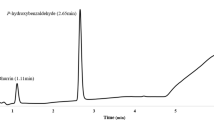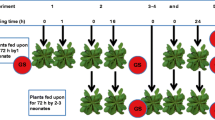Abstract
The garden geranium (Pelargonium xhortorum) has been shown to secrete anacardic acids in the form of a viscous sticky exudate from tall glandular trichomes, and this exudate provides a sticky trap defense against small pest species. The anacardic acids from genetically related pest-resistant and -susceptible plants have been characterized, and resistance has been shown to depend upon the presence ofω5 unsaturated anacardic acids. In this study, the biosynthesis of these anacardic acids was comparatively investigated by incubating [14C]methyl palmìtate, margarate, stearate, oleate and linoleate on floral buds of resistant and susceptible plants. In addition, the incorporation of [14C]valine, -isoleucine, and -leucine into anacardic acids was also studied. Nineteen anacardic acids were quantitated utilizing an improved HPLC technique. Fatty acids and, to a much lesser extent, amino acids were incorporated into anacardic acids. There are at least two pathways of biosynthesis operating: direct elongation, and β-oxidation with reincorporation of the [14C]acetate, the latter being more prevalent in the resistant plant. The amino acids were processed into branched chain anacardic acids, isoleucine being the precursor of the anteiso compounds, and valine the iso branched ones. The major difference between resistant and susceptible plants was the ability of resistant plants, but not the susceptible plants, to synthesizeω5 unsaturated anacardic acids. Both types of plants were capable of directly incorporating14C-labeled fatty acid methy esters into anacardic acids regardless of the plant's normal anacardic acid composition, thus bypassing the plant's tightly controlled regulation of the chemical structures of anacardic acids. No evidence was found forω5 desaturation of saturated anacardic acids. A revised biosynthesis scheme is presented.
Similar content being viewed by others
References
Baker, E.A., andHolloway, P.J. 1975. Branched-chain constituents of Brussels sprout wax.Phytochemistry 14:2463–2467.
Bjostand, L.B., Wolf, W.A., andRoelofs, W.L. 1987. Pheromone biosynthesis in lepidopterans: Desaturation and chain shortening, pp. 77–120,in G.D. Prestwich and G.J. Blomquist (eds.). Pheromone Biochemistry. Academic Press, New York.
Craig, R.,Mumma, R.O.,Gerhold, D.L.,Winner, B.L., andSnetsinger, R. 1986. Genetic control of a biochemical mechanism for mite resistance in geraniums, pp. 168–176,in M.B. Green and P.A. Hedin (eds.). Natural Resistance of Plants to Pests: Role of Allelochemicals. ACS Symposium Series 296, Washington, D.C.
Geissman, T.A. 1963. The biosynthesis of phenolic plant products, pp. 563–616,in P. Bernfeld (ed.). Biogenesis of Natural Compounds. Macmillan, New York.
Gerhold, D.L., Craig, R., andMumma, R.O. 1984. Analysis of trichome exudate from mite resistant geraniums.J. Chem. Ecol. 10:713–722.
Hesk, D.,Collins, L.C.,Craig, R., andMumma, R.O. 1990. Arthropod-resistant and -susceptible geraniums. Comparison of chemistry, pp. 224–250,in P.A. Hedin (ed.). Naturally Occurring Pest Bioregulators. ACS Symposium Series 449, Washington, D.C.
Jaworski, J.G. 1987. Biosynthesis of monoenoic and polyenoic fatty acids, pp. 159–174,in P.K. Stumpf (ed.). The Biochemistry of Plants: A Comprehensive Treatise, vol. 9. Academic Press, New York.
Lehninger, A.L. 1975. Biochemistry. Worth Publishers, New York. p. 567.
Radunz, A. 1987. On the function of methyl-branched chain fatty acids in phospholipids of cell membranes of higher plants, pp. 197–200,in P.K. Stumpf, J.B. Mudd and W.D. Nes (eds.). The Metabolism, Structure and Function of Plant Lipids. Plenum Press, New York.
Stark, R.S. 1975. Morphological and biochemical factors relating to spider mite resistance in the geranium. PhD thesis. The Pennsylvania State University, University Park, Pennsylvania.
Stumpf, P.K. 1987. The biosynthesis of saturated fatty acids, pp. 121–136,in P.K. Stumpf (ed.). The Biochemistry of Plants: A Comprehensive Treatise, Vol. 9. Academic Press, New York.
Walters, D.S. 1988. Biochemical and morphological characteristics involved in the pest resistance mechanism of geraniums. PhD thesis. The Pennsylvania State University, University Park, Pennsylvania.
Walters, D.S., Minard, R., Craig, R., andMumma, R.O. 1988. Geranium defensive agents III. Structural determination and biosynthetic considerations of anacardic acids in geranium.J. Chem. Ecol. 14:743–751.
Walters, D.S., Grossman, H.H., Craig, R., andMumma, R.O. 1989a. Geranium defensive agents IV. Chemical and morphological basis of resistance.J. Chem. Ecol. 15:357–372.
Walters, D.S., Craig, R., andMumma, R.O. 1989b. Glandular trichome exudate is the critical factor in geranium resistance to foxglove aphid.Entomol. Exp. Appl. 53:105–109.
Walters, D.S., Craig, R., andMumma, R.O. 1990a. Effects of mite resistance mechanism of geraniums on mortality and behavior of foxglove aphid (Acyrthosiphon solani Kaltenbach).J. Chem. Ecol. 16:877–886.
Walters, D.S., Craig, R., andMumma, R.O. 1990b. Fatty acid incorporation in the biosynthesis of anacardic acids of geraniums.Phytochemistry 29:1815–1822.
Walters, D.S., Craig, R., andMumma, R.O. 1990c. Heritable trichome differences of resistant and susceptible geraniums, pp. 317–327,in J. Casida (ed.). Pesticides and Alternatives: Innovative Chemical and Biological Approaches to Pest Control. Elsevier Science Publishers, Amsterdam.
Winner, B.L. 1975. Inheritance of resistance to the two-spotted spider mite,Tetranychus uriticae (Koch) in the geraniumPelargonium xhortorum (Bailey). MS thesis. Pennsylvania State University, University Park, Pennsylvania.
Author information
Authors and Affiliations
Rights and permissions
About this article
Cite this article
Hesk, D., Craig, R. & Mumma, R.O. Comparison of anacardic acid biosynthetic capability between insect-resistant and-susceptible geraniums. J Chem Ecol 18, 1349–1364 (1992). https://doi.org/10.1007/BF00994361
Received:
Accepted:
Issue Date:
DOI: https://doi.org/10.1007/BF00994361




